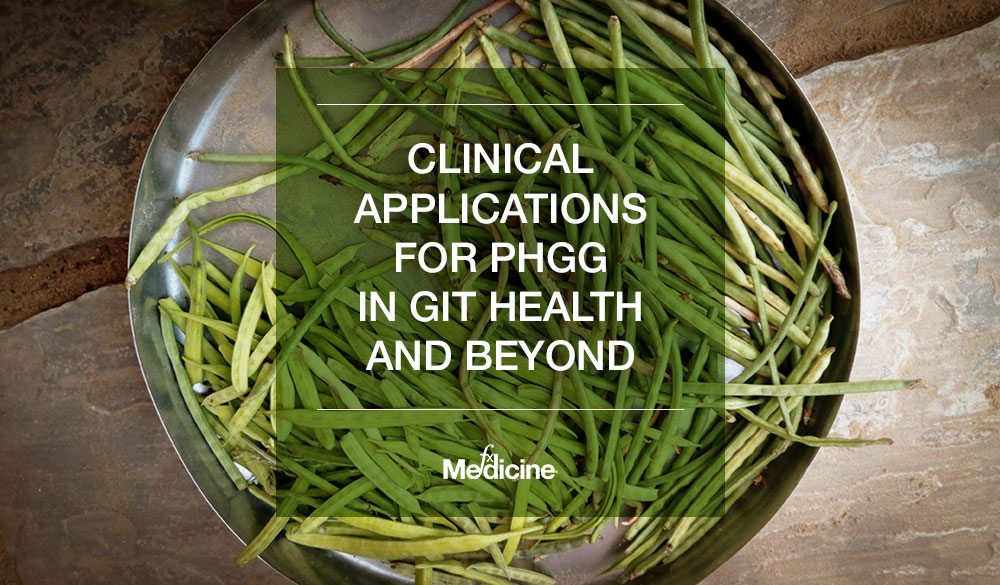Sara Dawood ● 2 min read
Partially hydrolysed guar gum (PHGG) is a prebiotic fibre that has been shown to enhance bifidobacterium and lactobacilli species as well as short chain fatty acids in the colon.[1]
Prebiotics are indigestible components of food that provide sustenance to colonic bacteria and promote the activity and proliferation of a variety of bacteria species.[1] Recent studies have investigated the benefits of PHGG in gastrointestinal tract (GIT) conditions such as irritable bowel syndrome (IBS), chronic abdominal pain (CAP), constipation, diarrhoea and small intestinal bowel overgrowth (SIBO) in adults and children.[1-6]
A prospective, randomised, double-blind, placebo-controlled study exhibited significant reductions in bloating and gas symptoms in IBS patients treated with 6g/day of PHGG.[1,4] While no other IBS symptoms were affected by PHGG in this study, a further study has shown promising results in alleviating other common IBS symptoms. The prospective, open-label observational study investigated the effects of PHGG in constipated IBS patients.[2] This study reported marked improvements in abdominal swelling, faecal output and colonic transit time, as well as reduced laxative and/or enema use. However, gender, age and BMI appeared to be influential factors. Another clinical trial investigated the efficacy of PHGG combined with the antibiotic rifaximin (traditionally used to treat IBS) in ameliorating SIBO and associated symptoms compared to rifaximin alone. Patients were randomly assigned either 1200mg/day of rifaximin or 1200mg/day of rifaximin plus 5g/day of PHGG and found the combination of PHGG and rifaximin to be more effective in eliminating SIBO.[3]
PHGG has also garnered positive findings in paediatric studies. The effect of PHGG in CAP and IBS symptoms was evaluated in one placebo-controlled paediatric trial, with improvements in stool output and symptom scores reported in patients who received 5g/day of PHGG per day compared to placebo.[4] Another randomised, double-blind, controlled trial assessed the use of PHGG added to a modified oral rehydration solution and its effects on acute diarrhoea in malnourished children. Treatment was more effective in reducing diarrhoea duration and increasing weight in the PHGG treated group.[5] Additionally, a study investigating the use of 6g/day of PHGG in constipated children with autism spectrum disorder demonstrated improvements in stool frequency and dysbiosis. As a result, serum inflammatory cytokine levels and irritability among the participants were reduced.[6]
PHGG has been found to be useful beyond GIT health, with one open-label, randomised controlled trial assessing the effects of soluble fibre from PHGG in patients with type 2 diabetes and the associated metabolic syndrome and cardiovascular risk factors. Patients who received 5g/twice daily of PHGG exhibited a reduction in a number of important biomarkers, including waist circumference, glycated haemoglobin, albuminuria and serum trans-fatty acids.[7]
References
- Niv E, Halak A, Tiommny E, et al. Randomized clinical study: Partially hydrolyzed guar gum (PHGG) versus placebo in the treatment of patients with irritable bowel syndrome. Nutrition & Metabolism 2016;13:10. [Full text]
- Russo L, Andreozzi P, Zito FP, et al. Partially hydrolyzed guar gum in the treatment of irritable bowel syndrome with constipation: effects of gender, age, and body mass index. Saudi J Gastroenterol 2015;21(2):104-110. [Full text]
- Furnari M, Parodi A, Gemignani L, et al. Clinical trial: the combination of rifaximin with partially hydrolysed guar gum is more effective than rifaximin alone in eradicating small intestinal bacterial overgrowth. Aliment Pharmacol Ther 2010;32(8):1000-1006. [Full text]
- Romano C, Comito D, Famiani A, et al. Partially hydrolyzed guar gum in pediatric functional abdominal pain. World J Gastroenterol 2013;19(2):235-240. [Full text]
- Alam NH, Ashraf, H, Kamruzzaman M, et al. Efficacy of partially hydrolyzed guar gum (PHGG) supplemented modified oral rehydration solution in the treatment of severely malnourished children with watery diarrhoea: a randomised double-blind controlled trial. J Health Popul Nutr 2015;34(3):235-240. [Full text]
- Inoue R, Sakaue Y, Kawada Y, et al. Dietary supplementation with partially hydrolyzed guar gum helps improve constipation and gut dysbiosis symptoms and behavioral irritability in children with autism spectrum disorder. Journal of clinical biochemistry and nutrition, 2019;64(3):217-223. [Full text]
- Dall’Alba V, Silva FM, Antonio JP, et al. Improvement of the metabolic syndrome profile by soluble fibre – guar gum – in patients with type 2 diabetes: a randomised clinical trial. British Journal of Nutrition 2013;110, 1601–1610. [Full text]
DISCLAIMER:
The information provided on FX Medicine is for educational and informational purposes only. The information provided on this site is not, nor is it intended to be, a substitute for professional advice or care. Please seek the advice of a qualified health care professional in the event something you have read here raises questions or concerns regarding your health.



